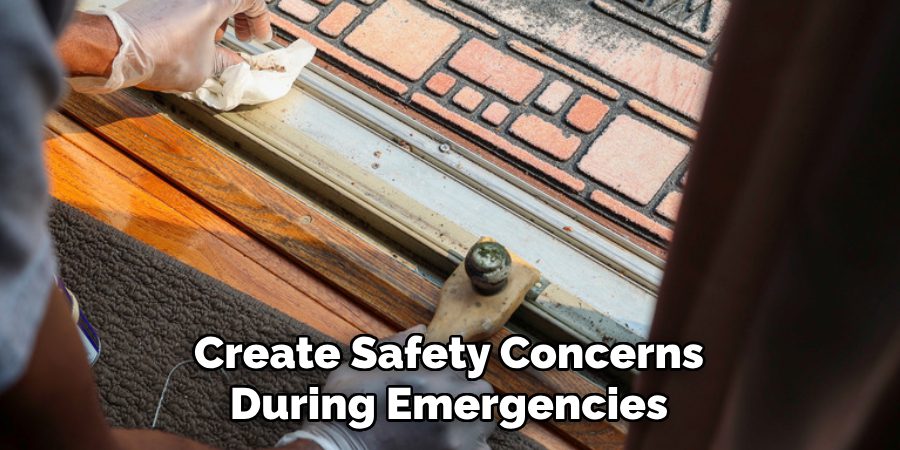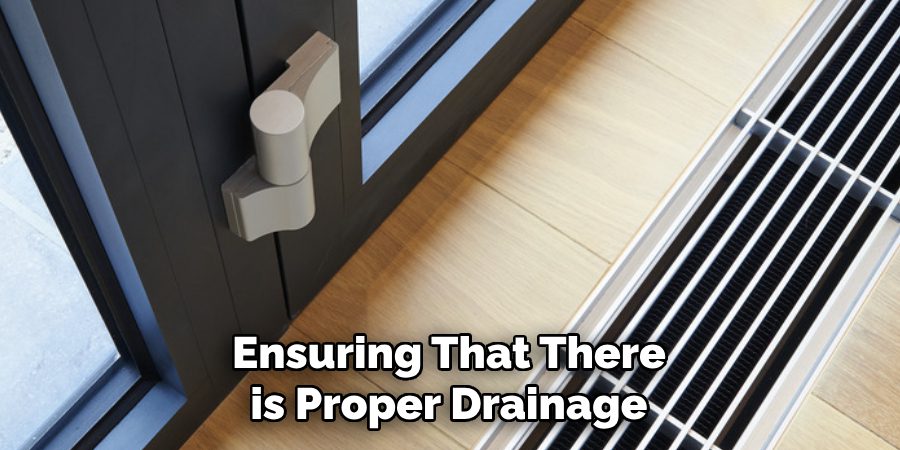During the colder months, freezing temperatures can cause patio doors to become stuck due to ice buildup, making them difficult to open and close. This can be both frustrating and inconvenient, especially when trying to access outdoor spaces.

Fortunately, there are practical methods to prevent your patio door from freezing shut, ensuring it remains functional even in the harshest winter conditions. This guide explores the key aspects of how to keep patio door from freezing shut. By taking a few proactive steps, you can save yourself time and effort while protecting your door from potential damage.
Why Patio Doors Freeze Shut in Winter
Patio doors freeze shut in winter primarily due to the combination of moisture and freezing temperatures. When cold air meets warm interior air near the door, condensation can form on the door’s surface and in the surrounding tracks or seals. If temperatures drop below freezing, this moisture quickly solidifies into ice, creating a barrier that restricts the movement of the door.
Additionally, snow or freezing rain can accumulate around the base of the door, further contributing to ice buildup. Poor insulation or damaged weather stripping can exacerbate this issue by allowing cold air to enter, increasing the likelihood of condensation and freezing. Understanding these factors is crucial for preventing ice from causing inconvenience and potential damage to your patio doors.
Common Issues Caused by a Frozen Patio Door
A frozen patio door can lead to several issues that disrupt both the functionality of the door and the comfort of your home. One of the most common problems is the inability to open or close the door, which can prevent access to outdoor spaces and potentially create safety concerns during emergencies. Additionally, forcing the door open can damage its components, such as the tracks, rollers, or seals, leading to costly repairs.

Ice buildup around the frame or on the weather stripping can also compromise the door’s insulation, allowing cold air to seep into your home and increasing heating costs. Over time, the repeated freezing and thawing cycle may cause wear and tear to the door’s seals and frame materials, reducing its overall lifespan. Addressing these issues quickly is important to maintain the functionality and efficiency of your patio door during winter months.
10 Methods How to Keep Patio Door from Freezing Shut
1. Seal the Door Properly
Properly sealing the door is one of the most crucial steps in preventing freezing. Over time, the weatherstripping around your patio door can wear out or become damaged, allowing cold air and moisture to seep in, leading to ice buildup.
Before the cold weather hits, inspect the weatherstripping for any gaps or cracks and replace it if necessary. You can also apply silicone sealant along the edges of the door frame to ensure a tight seal. By keeping drafts at bay, you reduce the likelihood of moisture accumulating around the door, which could lead to freezing.
2. Apply Lubricant to the Tracks
For sliding patio doors, ice can build up in the tracks, making it difficult for the door to slide open and closed. One of the best ways to prevent this from happening is by regularly lubricating the tracks with a silicone-based lubricant. This will help keep the tracks free of ice and debris, ensuring that the door slides smoothly.
Be sure to clean the tracks thoroughly before applying the lubricant, as dirt and debris can prevent the lubricant from working effectively. Regular maintenance of the tracks will not only prevent the door from freezing but will also extend the life of the door.
3. Install a Door Sweep
A door sweep is a simple but effective way to prevent cold air and moisture from seeping under your patio door. By installing a door sweep at the bottom of the door, you create a barrier that keeps cold air out and prevents moisture from accumulating on the floor or doorframe.

Door sweeps are available in various materials, including rubber, vinyl, and metal, and can be easily attached to the door’s base. This small investment can go a long way in keeping your patio door from freezing shut, especially if you live in an area with heavy snowfall or freezing rain.
4. Keep the Area Around the Door Dry
Moisture is one of the primary causes of a patio door freezing shut. When snow or rain gets trapped in the door’s frame or around the door’s edges, it can freeze and create a bond that locks the door in place.
To prevent this, make sure the area around the door stays dry. Regularly clear snow or ice from the doorstep, and use a towel or squeegee to wipe down any water that may have accumulated on the door. This simple habit will help prevent ice from forming around the door, making it easier to open when you need it.
5. Use a Deicer Spray
Deicer sprays are specifically designed to melt ice and snow quickly and efficiently. Using a deicer around the doorframe and tracks can help prevent ice from bonding to the door. These sprays work by lowering the freezing point of water, which helps break down any ice or snow that has accumulated.
Deicer sprays are especially helpful for doors that are exposed to heavy snowfall or freezing rain. However, it’s essential to use the deicer carefully, as some products can be harsh on paint or other materials. Be sure to follow the manufacturer’s instructions and apply the spray to areas that are most prone to freezing.
6. Install Storm Doors
Installing a storm door in front of your patio door is an excellent way to provide an extra layer of insulation and protection against the elements. Storm doors help to block out cold air and moisture, which can prevent ice from forming on the main patio door.

They also add an extra layer of security and can help reduce heating costs by improving the energy efficiency of your home. While storm doors can be an investment, they are a long-term solution that will provide year-round benefits in protecting your patio door from freezing shut.
7. Heat the Doorframe
In particularly cold climates, it can be beneficial to apply heat to the doorframe to keep it above freezing temperatures. You can use a space heater in the room near the door to increase the ambient temperature, or consider using a heated doorframe system, which is designed to keep the frame warm and dry.
These systems use low-voltage heating cables that are installed around the doorframe to prevent ice from forming. While this may require an initial investment, it can be especially effective for homes in extremely cold areas, preventing the door from freezing shut and ensuring that it remains functional.
8. Use a Tarp or Cover During Heavy Snowfall
If heavy snow or rain is forecasted, consider covering your patio door with a tarp or weather-resistant cover. This will prevent snow and moisture from accumulating on the door and frame, which can lead to freezing.
Simply drape the tarp over the door when you’re not using it, and secure it with ropes or bungee cords. When the weather clears up, remove the cover and inspect the door for any moisture buildup. This method is particularly useful during extreme weather events and can protect your door from freezing during the worst of the storm.
9. Keep the Patio Door Well-Insulated
Improving the insulation around your patio door can make a significant difference in preventing it from freezing shut. If your patio door is not well-insulated, cold air can seep in and cause condensation, which may freeze over time. You can enhance insulation by adding insulating film to the door’s glass panels or by using thermal curtains on the inside of the door.
Insulated window coverings can help trap heat inside and block out cold drafts, keeping the temperature around the doorframe above freezing and reducing the chances of it freezing shut.
10. Check and Maintain Drainage Around the Door
One often-overlooked factor in preventing a patio door from freezing shut is ensuring that there is proper drainage around the door. If water tends to pool around the base of the door, it can freeze and form a solid bond with the doorframe.

To prevent this, make sure that the area around the door is properly graded to allow water to drain away from the door. You can also install a drainage channel or trench near the door to direct water away. By ensuring that water doesn’t collect around the door, you can avoid the formation of ice and keep the door from freezing shut.
Conclusion
Preventing your patio door from freezing shut is essential for both convenience and home safety during the winter months. By taking proactive steps such as sealing the door, applying lubricants, keeping the area dry, and using deicers, you can keep the door in good working order throughout even the coldest months.
Installing storm doors, adding insulation, and maintaining proper drainage around the door can also help protect it from freezing. Thanks for reading our blog post on how to keep patio door from freezing shut! We hope you found it helpful and informative.

Professional Focus
Oliver Wood, a passionate patio designer, specializes in creating comfortable and inviting outdoor spaces that enhance relaxation and entertainment. His work combines a deep understanding of design with a love for nature, making him a standout professional in the field of outdoor living spaces. Through his thoughtful approach, he transforms everyday patios into extraordinary retreats for family and friends.
About the Author
Oliver Wood, a skilled patio designer, shares his expertise on outdoor living through his designs and insights. With a background in patio design and a genuine passion for creating beautiful spaces, he encourages others to invest in their outdoor environments, enhancing their homes with functional and inviting spaces for relaxation and entertainment.
Education History
University: Virginia Union University
Oliver’s education equipped him with the knowledge and skills to design patios that merge aesthetics with comfort, transforming outdoor areas into beautiful extensions of the home.
Expertise:
- Patio Design and Outdoor Living Spaces
- Functional and Aesthetic Landscaping
- Comfortable and Inviting Outdoor Environments
- Design Philosophy for Family-Oriented Spaces
- Creating Spaces for Relaxation and Entertainment
